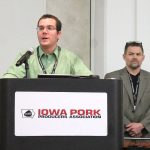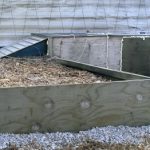Daniel Andersen, Iowa State University assistant professor in the College of Engineering and College of Agriculture and Life Sciences, says the sulfur levels in hog manure have increased due to hog farmers becoming better at water conservation, thus not as much manure is being created, but he points to a larger culprit in the introduction …Continue reading “Andersen: Hydrogen sulfide the invisible killer in hog manure”
A father and his son who were so close that they were “like glue” were killed Saturday by noxious fumes from a northwest Iowa hog manure pit — the second father and son in the Midwest to die of poisonous manure pit gases this month. It takes just a few seconds for routine maintenance work …Continue reading “Andersen comments on the danger of manure pit fumes”
A $1 million Iowa Pork Producers Association-funded research project on pit foaming has entered its third year. Researchers provided an update at the Iowa Pork Congress in Des Moines. “Our goal is to find and correct the mechanisms of foaming,” said Steve Hoff, an agricultural and biosystems engineering professor at Iowa State University and project …Continue reading “Pit foaming research continues”
A team of Iowa State University specialists has developed an online tool to help livestock and poultry producers compare odor-mitigation techniques. The Air Management Practices Assessment Tool is web-based, available at www.agronext.iastate.edu/ampat at no charge. “The website was developed to help livestock and poultry producers identify practices to reduce odors, and emissions of gases and …Continue reading “New tool evaluates odor reduction”
Hog producers use a great quantity of water, and in addition to water conservation being the environmentally correct thing to do, producers have a number of other reason to watch every drop they use in their operation. Daniel Andersen, Iowa State University assistant professor in the department of Agricultural and Biosystems Engineering, talks swine operation …Continue reading “Water conservation adds up in swine operations”
A team of Iowa State University Extension and Outreach specialists have developed an online tool to help livestock and poultry producers compare odor mitigation techniques that could be useful on their farms. Air Management Practices Assessment Tool, AMPAT for short, is web-based and available at no charge at www.agronext.iastate.edu/ampat. “The website was developed to help …Continue reading “New tool evaluates options for reducing odors in livestock operations”
A new blog from Iowa State University professor Dan Andersen discusses topics pertaining to the science of manure. Andersen says he will be writing about how manure is handled, options for treatment, how to effectively use it as a fertilizer, potential environmental impact and new technologies being developed to improve manure use. The most recent …Continue reading “Andersen offers new “Manure Scoop” blog”
From July 13 to July 16, the hallways in Elings Hall and Sukup Hall were a little vacant. This was due to many in the Department of Agricultural and Biosystems Engineering attending the 2014 ASABE (American Society of Agricultural and Biological Engineers) annual international meeting in Montreal. Faculty, staff and students were in attendance, and several were recognized …Continue reading “ABE recognized for achievement and advancement at annual conference”
Air Management Practices Assessment Tool Evaluation of polymer to reduce emissions from swine finishing facilities Estimating methane emissions Anaerobic digestion’s impact on odor, ammonia Diets that reduce ammonia emissions from hen houses Environmental assessment of laying-hen housing systems Quantifying emissions from swine facilities Community assessment model (CAM) for odor dispersion Biofilters conference and educational modules …Continue reading “Selected current ISU livestock odor and air quality research and extension”


